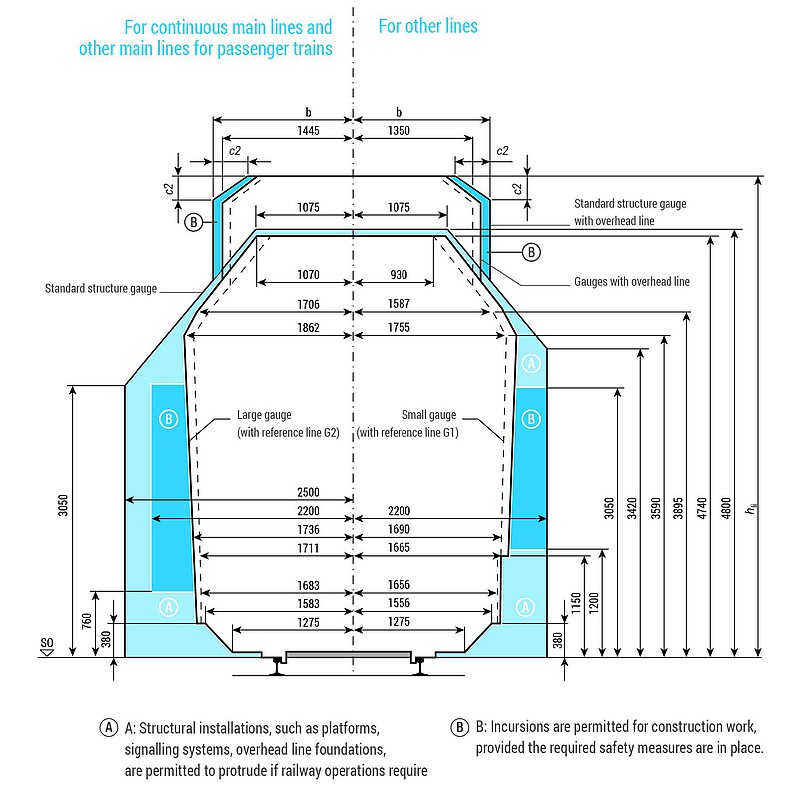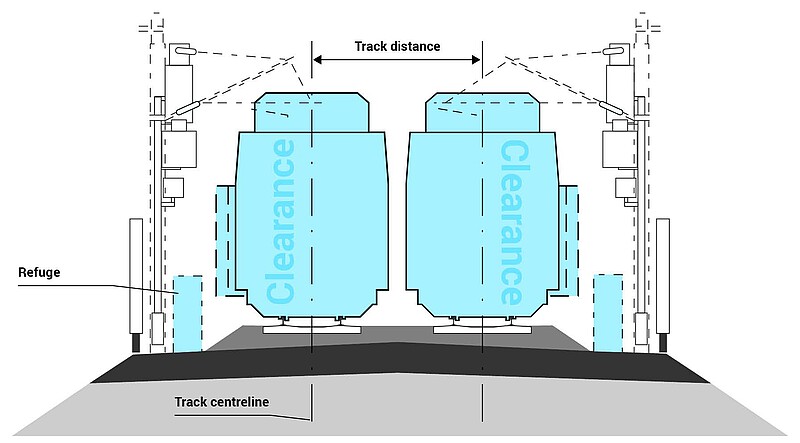Structure gauge
Trains running on railway lines cannot avoid obstacles due to the constraints imposed by running on a guiding track. Gauge is about the compatibility between the train and the infrastructure around it. Gauging, therefore, defines an area over the track cross-section which has to be kept clear of all fixed track installations and other fixed obstacles to ensure the safe movement of the vehicle. The absolute gauge results from taking account of allowances for vehicle dynamic movements. It represents the space required to allow for this movement, called the swept envelope. The minimum clearance results from individual measurements to this envelope taking account of the reserves necessary for carrying out track maintenance (maintenance tolerances). In the UK these track tolerances are based on three stages of track fixity, which is how track position varies with time and use. High fixity comes from slab track; medium fixity from glued ballast and low fixity from normal ballasted track.
As vehicles travel on a route there will be particular places where the clearances have been allowed to be reduced to a minimum. Additional measures will be required at these locations to ensure that clearances are managed. If obstacles, such as trees, project into this space, this can result in a collision with the train so that continued safe operation of the infrastructure cannot be maintained. This provides an additional responsibility upon the infrastructure manager to ensure the safe passage of trains. Based on the considerations of gauge, absolute gauge and minimum clearances, infrastructure managers frequently set the structure gauge specific to a route as standard (standard structure gauge, standard clearance). This simplifies planning considerably.

© Keeping Track of Track Geometry
EBO Article 9:
“The standard gauge is composed of the space enclosed by the relevant boundary and additional spaces for construction and operational purposes”.
EisbBBV (Austrian Railway Construction and Operations Regulation) Article 16:
“The structure gauge is the space which is part of the track and has to be kept clear. The structure gauge is composed of the space required for the unhindered travel of rail vehicles and additional spaces for construction and operational purposes. The structure gauge shall be specified by the railway infrastructure manager on the basis of the relevant kinematic gauge line in accordance with the state of the art; this specification may be dependent on the railway line.”
[…]
“The minimum structure gauge encloses the space required by a rail vehicle taking account of horizontal and vertical movements as well as track geometry tolerances and minimum distances from overhead line equipment. To calculate the minimum structure gauge, the dimensions of the relevant kinematic reference line shall be extended in accordance with the state of the art.”
AB-EBV (Swiss Implementing Provisions of the Railway Regulation):
“The structure gauge [...] is the envelope of the space to be kept clear for the transit of vehicles and other operational purposes. It comprises the boundary of fixed installations and the additional refuges required.”
Refuges shall be provided on both sides of the line and ensure the safety of staff whilst trains are passing. If the track area has to be cleared, e. g. because of a passing train, staff have to immediately move into the refuge.
UK Railway Group Standard GIRT7073 defines structure clearance as:
“The minimum calculated distance between a structure and the swept envelope of a specific type of vehicle passing at nominated speeds, taking account of appropriate track tolerances and accuracy of measurement”.
On a double track, the rails have to be arranged in such a way that vehicles can pass without danger at the permissible speed.
Recommended specialist book
Hansmann, Fabian; Nemetz, Wolfgang; Spoors, Richard, Keeping Track of Track Geometry
https://www.pmcmedia.com/en/all-titles/rail/428/keeping-track-of-track-geometry

